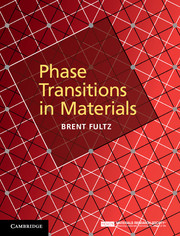Book contents
- Frontmatter
- Dedication
- Contents
- Preface
- Acknowledgments
- Notation
- Part I Basic thermodynamics and kinetics of phase transformations
- Part II The atomic origins of thermodynamics and kinetics
- Part III Types of phase transformations
- 10 Melting
- 11 Transformations involving precipitates and interfaces
- 12 Spinodal decomposition
- 13 Phase field theory
- 14 Method of concentration waves and chemical ordering
- 15 Diffusionless transformations
- 16 Thermodynamics of nanomaterials
- 17 Magnetic and electronic phase transitions
- 18 Phase transitions in quantum materials
- Part IV Advanced topics
- Further reading
- References
- Index
11 - Transformations involving precipitates and interfaces
from Part III - Types of phase transformations
Published online by Cambridge University Press: 05 September 2014
- Frontmatter
- Dedication
- Contents
- Preface
- Acknowledgments
- Notation
- Part I Basic thermodynamics and kinetics of phase transformations
- Part II The atomic origins of thermodynamics and kinetics
- Part III Types of phase transformations
- 10 Melting
- 11 Transformations involving precipitates and interfaces
- 12 Spinodal decomposition
- 13 Phase field theory
- 14 Method of concentration waves and chemical ordering
- 15 Diffusionless transformations
- 16 Thermodynamics of nanomaterials
- 17 Magnetic and electronic phase transitions
- 18 Phase transitions in quantum materials
- Part IV Advanced topics
- Further reading
- References
- Index
Summary
Most phase transformations in materials occur by nucleation and growth, where a small particle of the new phase nucleates in the parent phase, and then grows as atoms diffuse to its surface. Especially at low temperatures, the first new particles can be quite small, and their crystal structures may differ from the equilibrium phases that form with increased temperature or longer times. A nucleus of a distinct phase must have an interface to the surrounding parent phase. This interface between the precipitate and matrix has an atomic structure and chemical composition that is not simply a termination of bulk crystal of the precipitate and the matrix. For free surfaces and for interfaces between crystals, this chapter explains important aspects of surface energy, surface thermodynamics, and kinetic processes at surfaces. Most solid-solid phase transformations require some consideration of elastic energy, and the balance between surface energy, elastic energy, and volume free energy is altered as a precipitate grows and changes its shape.
Chapter 4 presented concepts of nucleation in a homogeneous medium or at a generic surface, but additional microstructural aspects of nucleation are presented here. Diffusional transport to the new phase often controls the rate of growth, and the rate of the phase transformation. Some examples are given, but numerous nucleation and growth transformations in different materials have received significant study. The eutectoid transformation is described, and its role in steel metallurgy is discussed in brief.
Information
- Type
- Chapter
- Information
- Phase Transitions in Materials , pp. 268 - 297Publisher: Cambridge University PressPrint publication year: 2014
